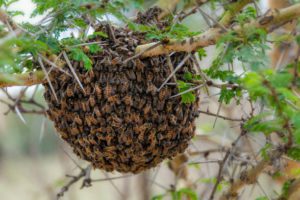 Bees are known for doing lots of different things, such as flying, buzzing, and pollinating flowers. But something else that bees do is swarm, which is how bee colonies continue to survive and create new colonies. Swarming is a natural and essential part of a bee’s life, but seeing a swarm of bees can be very concerning for an unsuspecting homeowner.
Bees are known for doing lots of different things, such as flying, buzzing, and pollinating flowers. But something else that bees do is swarm, which is how bee colonies continue to survive and create new colonies. Swarming is a natural and essential part of a bee’s life, but seeing a swarm of bees can be very concerning for an unsuspecting homeowner.
Here is what you should know about bee swarms and what to do when you see swarms of bees around your house.
What Are Bee Swarms?
A bee swarm looks like a mass of bees moving together through the air. Bees swarm for a few different reasons. For example, swarming occurs when a bee hive gets too crowded and some of the bees must move on to a different location. Also, all of the bees in a colony might leave an existing hive because of lack and food or water, a human disturbance, or other issues that put the bees at risk.
Why Swarms of Bees Are a Problem
Bee swarms can be very unsettling to see around your home, but swarming time is actually when bees are most docile. At this time, the bees are primarily concerned with relocating rather than defending themselves. After a swarm of bees find its new home, they will return to defensive mode in full force to protect the queen as she lays eggs and as they start building wax comb.
Yet bee swarms can be problematic for homeowners because of the fear they cause people, especially kids and anyone who is allergic to bees. Pest control companies like Precise Termite & Pest Control, often receive panicked phone calls from residents about bee swarms. But it’s important to remember that bees are essential to our ecosystem, that swarming bees are typically less dangerous than non-swarming bees, and that we are just a phone call away (866-971-2847) whenever you need help.
When and How Long Bee Swarms Happen
Bee swarms are most common during the spring, but they can happen any time between spring and fall. The most common months for bee swarms are April, May, and June.
Bees are most likely to swarm on days with pleasant weather and between the hours of 10am and 2pm. Swarming may last between 24 and 36 hours. The swarm may linger in your yard for just a few hours up to a couple days before moving on.
What You Should Do If You See Swarms of Bees
Although it might be difficult in the moment, the first thing to do when you see a swarm of bees is to react calmly and not panic. For your own safety, do not attention to corral the swarm, spray it, catch it, or disturb it in any way. Dealing with bees requires protective gear and training in beekeeping.
Swarms of bees are actually quite beautiful to watch, so you might even want to grab your phone and take a video – from a safe distance away, of course. If the swarm becomes problematic, you can contact your local beekeeper association to have a beekeeper come out to your property and catch the swarm and transfer them to a backyard apiary. You can also contact Precise Termite & Pest Control for professional bee elimination services. We are committed to serving the counties of Bergen, Passaic, Morris, Essex, and Sussex.
Contact us to learn more about our bee services or to schedule your free bee inspection.





